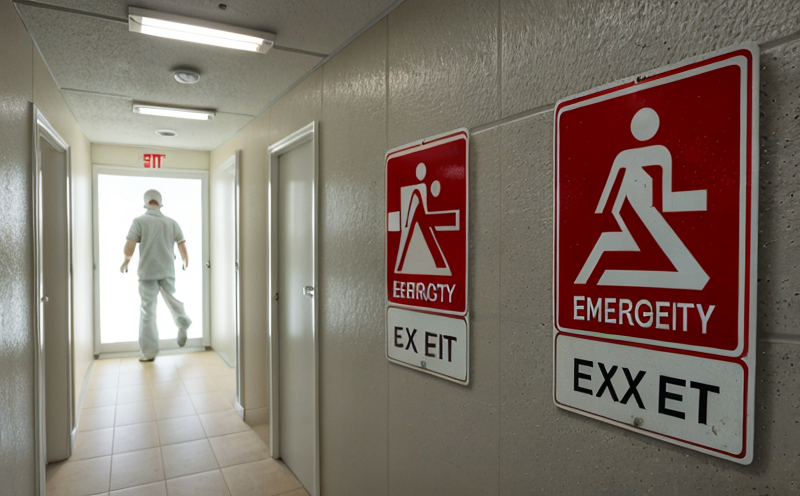Emergency Lighting and Signage Integration Testing
Emergency lighting and signage integration testing is a critical aspect of fire safety compliance. The purpose of this test is to ensure that emergency lighting systems, exit signs, and related components function effectively in the event of an evacuation. This service ensures that the lighting and signage can be activated promptly and that they provide clear and unambiguous directions for safe egress. Compliance with international standards such as ISO 7010:2016, EN 50173-2, and NFPA 101 is mandatory in many regions to ensure public safety. The testing process involves several key steps:- Initial site survey to assess the layout of emergency lighting fixtures and signage.
- Activation tests to verify that lights can be activated by a manual switch or automatically when power is lost.
- Performance checks for visual legibility, brightness, and duration under specified conditions.
- Testing of photometric performance to ensure adequate illumination levels in dark environments.
- Verification of signage compliance with color coding and symbols prescribed by relevant standards.
Applied Standards
Testing for emergency lighting and signage integration is governed by a variety of international standards designed to ensure the highest level of safety and reliability in fire-affected environments. The most commonly referenced standards include: - ISO 7010:2016, which specifies pictograms for use on signs and labels. - EN 50173-2, which sets out requirements for emergency lighting systems. - NFPA 101, the Life Safety Code, which provides comprehensive guidelines for building safety. These standards ensure that all components of the system are tested to meet specific performance criteria. For example:- ISO 7010:2016 ensures that exit signs and other critical symbols are clearly visible under specified conditions.
- EN 50173-2 mandates testing for the integrity and functionality of emergency lighting systems, ensuring they remain operational in power failure situations.
- NFPA 101 provides detailed guidance on how to design buildings that minimize risk during emergencies.
Scope and Methodology
The scope of emergency lighting and signage integration testing encompasses a wide range of components involved in the evacuation process. This includes: - Emergency exit signs: These must be clearly visible and provide accurate directions for safe egress. - Emergency lighting fixtures: These need to function effectively during power outages, providing sufficient illumination levels throughout the facility. - Photometric testing: Ensuring that emergency lights meet specified brightness requirements. - Operational checks: Testing the activation of systems both manually and automatically. The methodology involves a detailed approach:- Initial inspection to assess the placement and visibility of signs.
- Activation tests to ensure all components can be activated as designed.
- Performance checks for brightness, duration, and visual legibility.
- Photometric testing using specialized instruments to measure light levels.
Competitive Advantage and Market Impact
In a competitive market, ensuring compliance with fire safety regulations is not just a legal requirement but also a key differentiator. By providing comprehensive emergency lighting and signage integration testing, laboratories can offer clients peace of mind and demonstrate their commitment to public safety.- Enhanced reputation: Clients trust providers who consistently meet high standards.
- Increased market share: Compliance with stringent regulations can set a company apart from competitors.
- Reduction in liability risk: Ensuring that all systems are up to standard minimizes the risk of legal action and penalties.
Frequently Asked Questions
What are the key components tested in emergency lighting and signage integration?
The key components include emergency exit signs, emergency lighting fixtures, photometric performance, and operational checks. These tests ensure that all elements function effectively during an evacuation.
Why is photometric testing important?
Photometric testing ensures that emergency lights meet specified brightness requirements, which are critical for visibility in dark environments. This helps ensure that evacuees can see clearly and safely navigate the facility.
What standards govern this type of testing?
Testing is governed by several international standards, including ISO 7010:2016 for pictograms and symbols, EN 50173-2 for emergency lighting systems, and NFPA 101 for life safety codes.
How often should these tests be conducted?
Tests should be conducted at regular intervals to ensure ongoing compliance with safety regulations. The frequency will depend on the specific requirements of the facility and local regulatory guidelines.
What are the potential consequences of failing these tests?
Failing these tests can lead to significant legal ramifications, including fines and penalties. More importantly, it compromises public safety by reducing trust in building evacuation systems.
How do you prepare the specimen for testing?
Preparation involves ensuring that all components are installed correctly and are powered. For photometric tests, this includes calibrating instruments to ensure accurate measurements.
What is the role of testing in building compliance?
Testing ensures that buildings meet all relevant safety standards and regulations. This is crucial for maintaining public trust and ensuring that evacuation procedures can be relied upon during emergencies.
How does this service benefit quality managers?
This service provides detailed insights into the performance of emergency lighting and signage. It helps quality managers identify areas for improvement and ensure that all systems are up to standard.





